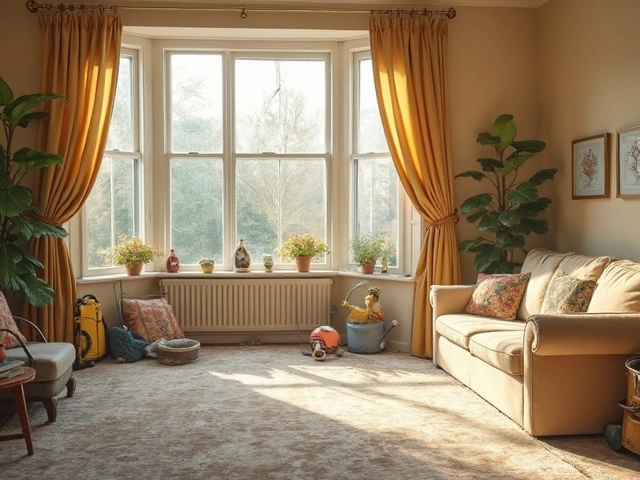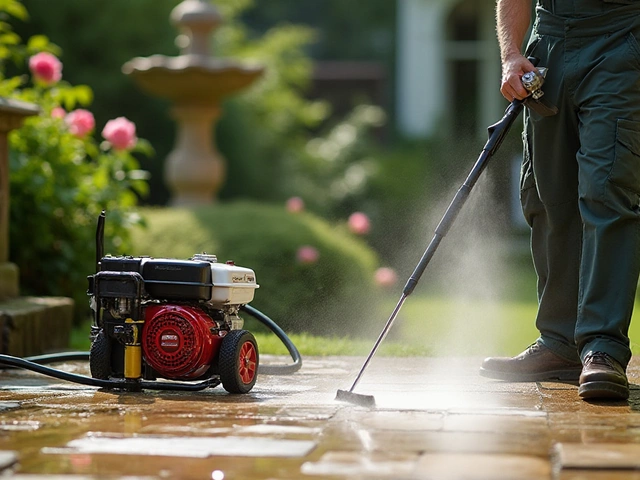Ask five people why we say “spring clean” and you’ll get five different answers-sunshine, tradition, new starts, “my nan always did it after the coal fire season.” The truth blends history, hacks, and a bit of biology. Here’s where the phrase came from, why spring is the sweet spot, and a simple way to do it now without losing a weekend.
- TL;DR
- “Spring clean” took off in the 1800s when homes needed a deep scrub after smoky winters; newspapers and housekeeping manuals from the period popularised it.
- Spring works because days are longer, air is drier and milder, and you can open windows to flush dust, smells, and VOCs without freezing.
- It’s not just British: Jewish Passover prep, Persian Nowruz “khaneh tekani,” and Chinese spring tidying echoed the same idea-reset the home before a new season.
- A spring clean is a once-a-year deep reset: above-head height, textiles, hidden grease, windows, and stuff you postpone all winter.
- Short on time? Use the 3-box declutter (Keep/Release/Relocate), top-down cleaning, and a one-weekend plan below.
What the phrase really means and where it came from
When people say a spring clean, they mean a deep, seasonal reset-heavier than your weekly tidy, lighter than a builder’s clean. It’s the one where curtains come down, rugs go outside, and you finally face the tops of wardrobes. The idea feels timeless, but the phrase is modern enough to track. By the mid‑1800s, British and American newspapers were already using “spring cleaning/spring‑cleaning” as a familiar term, and 19th‑century housekeeping manuals treated it as a normal domestic event. The Oxford English Dictionary records 19th‑century citations, so we’re not guessing here.
Why then? Coal and wood. In Victorian Britain and elsewhere, winters meant sealed rooms, open fires, oil lamps, and soot on every surface. By March or April, the cold eased, the days stretched, and you could throw open windows without inviting in frost. That’s when families beat rugs, shook bedding in the yard, scrubbed smoke‑stained paint, and sent mattress ticking to be aired. The season did the heavy lifting: light to spot grime, dry air to help everything cure, and a breeze to carry dust out of the house-not deeper into it.
It’s not just a British quirk. Jewish households have long cleaned carefully before Passover to remove chametz (leaven), a ritual with practical consequences for dust and crumbs. In Iran, Nowruz welcomes spring with “khaneh tekani” (literally “shaking the house”), a whole‑home refresh before the new year. In China, households tidy ahead of Lunar New Year, then avoid sweeping on the day itself. Japan’s big clean, “o‑soji,” lands at year‑end rather than spring, but it’s the same reset logic. The pattern is clear: many cultures tie heavy cleaning to a seasonal or spiritual new start.
Language followed practice. The hyphenated verb “to spring‑clean” shows up alongside the noun “spring cleaning,” especially in British usage. In the UK, both forms are common; in the US, “spring cleaning” dominates as the noun. Either way, the phrase stuck because the job was memorable, once-a-year big, and very obviously tied to the weather.
One more reason the term endured: technology changed the timing, not the need. Central heating, vacuum cleaners, microfibre cloths-they all made winter less sooty, but they didn’t remove the pay‑off you get when you open everything up and do a deliberate reset. Modern life just shifted which tasks go in the spring pile.
Why spring works: light, air, and body clocks (plus UK reality)
Spring isn’t magic, but conditions help. Here’s the practical stuff you can bank on in the UK between March and May.
- Longer daylight. More light shows dust and streaks you miss under winter bulbs, so you actually clean better. You also get more energy-circadian rhythms perk up as day length grows. People often feel more motivated once the clocks change.
- Milder, drier air. The Met Office’s spring averages are kinder for drying textiles and paint than December or January. Open windows for cross‑ventilation and things dry quickly without freezing your fingers off.
- End of “heating season.” When radiators stop pumping 24/7, you can move furniture, bleed rads, vacuum behind them, and deal with the grime baked onto skirting and sills.
- Ventilation beats VOCs. Paints, cleaning agents, and furniture off‑gas VOCs. Opening windows clears them. Spring ventilation is efficient-you get a big indoor air exchange for free.
- Allergy timing. If you have hay fever, late spring can be tricky outdoors, but ventilation helps reduce indoor dust mite allergens. NHS guidance points to dust mites as a major trigger; hot washes, encasing bedding, and regular vacuuming with a HEPA filter are your friends.
Here in Brighton, you also get sea air and wind-great for airing duvets on a dry day. If you’re coastal or high‑rise, clip bedding and rugs so they don’t try to visit the neighbours. If you’re rural, pick a day without heavy pollen if that sets you off; clean indoors with windows cracked and blast the full airing another day.
So why not autumn? You can do a deep clean any time, but spring rates well on a simple triangle: visibility (light), drying time (air), and motivation (mood). Autumn often brings damp spells and less light. Summer is great for drying, but people are out and about, and pollen can be high. Winter is the hardest for ventilation. If your calendar is packed in April, pick another dry spell-but keep the same logic.
One more practicality: UK households tend to declutter in spring because fiscal year‑end (early April) and school terms create natural “what’s staying, what’s going” moments. Charity shops notice the surge. That makes it easier to donate and get bulky items picked up.

What a real spring clean includes (and a plan that won’t eat your weekend)
If you only remember one line, make it this: work top‑down, dry‑to‑wet, clean‑to‑dirty, and in one direction (clockwise) so you see progress. Here’s the simple plan.
First, collect a small kit so you’re not running to the cupboard every five minutes.
- Microfibre cloths (light and dark), a glass cloth, and a couple of scrub pads
- Mild all‑purpose cleaner, washing‑up liquid, white vinegar, bicarbonate of soda
- Vacuum with crevice/dusting tools and a HEPA filter if you have allergies
- Extendable duster for high spots
- Bucket, squeegee, rubber gloves, bin bags
- Optional: steam cleaner for grout and textiles, wood polish/wax if appropriate
Then choose your format based on time.
Only 3 hours? Do a “lite” spring reset:
- Declutter surfaces with the 3‑box method: Keep, Release (donate/sell), Relocate (belongs in another room). Set a timer-15 minutes per room.
- High dust: tops of cabinets, door frames, light fittings. Use the extendable duster. One pass.
- Textiles triage: strip beds, gather towels and throws for hot washes or a sunny airing.
- Kitchen blitz: degrease hob trim, wipe cupboard doors, clean sink and drain (bicarb + vinegar, then hot water).
- Bathroom shine: descale taps/shower screen, wipe grout lines with a baking soda paste.
- Floors: vacuum edges and under beds/sofas with crevice tool; quick mop hard floors.
One weekend? Do the full spring clean by zone. You’ll feel it Monday, but your home will too.
- Bedrooms and textiles (Saturday morning)
- Mattress: vacuum both sides, treat stains lightly, rotate/flip if the manufacturer allows. Consider a breathable mattress protector.
- Bedding and curtains: launder per labels. If dry only, air on a breezy day, give a fabric refresh spray, or steam lightly.
- Wardrobes: edit clothing. Use the 20/20 rule-if it costs under £20 and you can replace in under 20 minutes, you don’t need “just in case” duplicates.
- Kitchen (Saturday afternoon)
- Fridge/freezer: quick inventory, wipe shelves, bin science experiments. Keep a cool bag ready if you need to power down.
- Oven: apply a gel cleaner or bicarb paste; let dwell, then scrub and rinse. Pull out and vacuum behind if safe to do so.
- Extractor and cupboards: degrease filters; wipe doors and handles. Check dates and consolidate dry goods.
- Small appliances: descale kettle/coffee maker; crumb‑tray the toaster; wipe microwave seals.
- Bathrooms (Sunday morning)
- Limescale: soak shower heads in vinegar; paste clean around taps.
- Grout: steam or use a mild oxygen‑based cleaner; re‑seal if needed.
- Cabinets: toss expired products; wipe mirrors and vents.
- Living areas and windows (Sunday afternoon)
- Rugs: take outside, beat if possible; vacuum both sides.
- Sofas: vacuum crevices; rotate cushions; spot‑clean arms.
- Windows: inside and out if you can reach safely. Use two‑cloth method-one damp, one dry-then squeegee for the panes.
- Finish with skirting, sockets/switch plates (lightly damp cloth), and a thorough floor routine.
Common pitfalls to avoid:
- Spreading mess between rooms. Finish a zone before starting the next.
- Cleaning before decluttering. You’ll double your work.
- Washing windows in full sun. Streak city. Choose bright shade.
- Heavy scrubbing on painted wood. Use a mild cleaner and a soft cloth.
- Forgetting ventilation. Crack windows when using chemicals, even “eco” ones.
Quick cheat‑sheets you can screenshot:
- 5 high‑impact wins: windows, textiles, oven/extractor, mattress, skirting/edges.
- 5 often‑missed spots: top of fridge, behind radiators, under sofa, door hinges, shower screen seals.
- Fast declutter script: “Would I buy this again today?” If not and it’s not sentimental or useful, it goes.
- Allergy protocol: hot wash bedding 60°C weekly for spring, HEPA vacuum twice a week in bedrooms, encase pillows and mattress, dry fully before making the bed.
Deep clean vs spring clean vs end‑of‑tenancy (plain English version):
- Spring clean: seasonal reset you control-focus on textiles, windows, high dust, greasy build‑up, and hidden edges.
- Deep clean: any top‑to‑bottom intensive job-could be spring, pre‑baby, post‑renovation. Often includes inside cabinets and appliances.
- End‑of‑tenancy: landlord standards, inventory‑ready. Inside every cupboard, oven to “photographable,” limescale gone, skirtings spotless.
Examples, quick answers, and next steps for different homes
Real‑world examples help you judge effort. Here are three I’ve seen around Brighton.
One‑bed flat, no pets, tidy person: Three‑hour “lite” reset nails it. Windows, textiles, bathroom limescale, and a proper vacuum with edges. Feels brand new for Monday.
Family of four, two small kids, one cat: Do the weekend plan. Prioritise mattresses, bedding, sofa, oven, extractor, windows, and under‑furniture dust. Keep a toy crate for “strays” in each room. Run the dishwasher on a cleaner cycle at the end.
Shared house, three renters: Split zones: one does kitchen and extractor, one does bathrooms, one does windows and living areas. Everyone does their own room. Agree on a two‑bag rule per person (donate and bin) to avoid stalemates.
Mini‑FAQ
Why is it called a “spring clean” and not just a deep clean? Because it’s tied to the season. The job kicked off when people could finally fling open windows after winter fires. The name marks timing as much as intensity.
When did the term show up? Mid‑19th century in British and American sources. The Oxford English Dictionary and digitised newspaper archives from that period use “spring cleaning/spring‑cleaning.”
Is spring the only time to do it? No. The principles-ventilate, use light, dry fast-work any season. Spring just gives you the best odds in the UK. If you’re slammed in April, pick the next bright, dry spell.
I have hay fever. Should I open windows? Yes, but be tactical. Ventilate rooms during lower pollen times (often mid‑day near the coast; early morning inland can spike). Use a HEPA air purifier in bedrooms, hot‑wash bedding weekly, and shower hair before bed.
Southern Hemisphere? Flip it. Your “spring clean” lands in September-November. The logic stays the same: pick your lighter, drier, brighter window.
Renting-do I need a spring clean if I pay for end‑of‑tenancy later? Yes, if you like living well. Spring keeps allergens down and appliances happier. End‑of‑tenancy is for handing keys back, not for daily comfort.
Eco questions: vinegar on everything? Not on stone (marble, some granites) or unfinished wood. Use pH‑neutral cleaners there. Vinegar is fine for glass, chrome, and many tiles. Always test small first.
Do I really have to take curtains down? If you’ve got traffic soot, a wood burner, or a pet, yes-annually is ideal. If not, a good vacuum with the upholstery tool and a sunny airing can buy you another season.
Decision rules you can use without thinking:
- Big stuff first, or it never happens. Windows and textiles pay off most in “freshness.”
- Don’t deep‑clean storage for things you don’t want. Declutter before you wipe shelves.
- Two‑minute test: if a job takes under two minutes (wipe a handle, empty the crumb tray), do it now so it doesn’t hit your weekend list.
- Wet after dry: dust, then damp wipe. Vacuum, then mop. That order saves time.
Next steps by scenario
- Busy professional, tiny flat: Book a Saturday morning slot every March for the “lite” plan. Set a calendar repeat. Outsource windows twice a year if you’re high‑rise.
- Allergy household: Add a spring bedding protocol-hot wash weekly for April-June, encase pillows/mattress, HEPA vacuum in bedrooms, and a quick damp‑dust nightly during peak pollen weeks.
- Pet owners: Spring is coat‑blow season. Groom outside on dry days, wash pet bedding hot, and add a rubber brush pass on sofas after vacuuming.
- Renovation survivors: Do a spring‑style deep clean once the dust settles-ceilings, vents, tops of doors, window tracks, then everything else. Consider a one‑off pro visit if plaster dust keeps returning.
- Landlord/agent standards: Use the end‑of‑tenancy list as your spring template this year. It’s a harsher test-and your place will sparkle.
Credibility notes
- Origins/usage: The Oxford English Dictionary and 19th‑century British/American newspaper archives document “spring cleaning/spring‑cleaning.”
- UK conditions: Met Office seasonal summaries back up the drying and light advantages of spring.
- Allergies: NHS guidance highlights dust mites as a key indoor trigger; hot washing and HEPA filtration reduce exposure.
- Traditions: Passover cleaning, Nowruz “khaneh tekani,” and pre‑festival tidying across cultures reinforce the seasonal reset effect.
Last tip: schedule it. Pick one dry weekend in spring, text a friend to keep you honest, and promise yourself a reward after windows and textiles. A proper spring clean isn’t a punishment; it’s a reset you can feel when you wake up on Monday and the place smells like fresh air instead of last winter.




